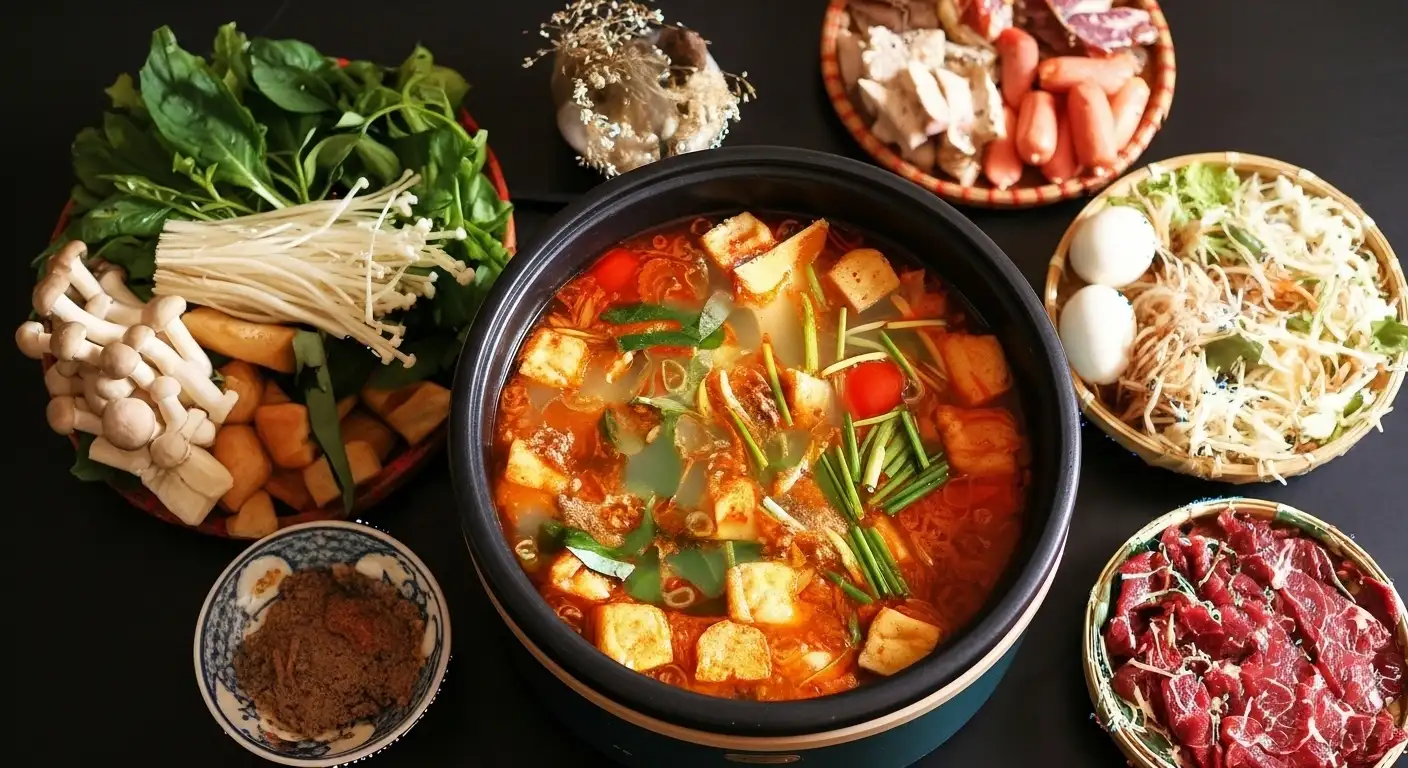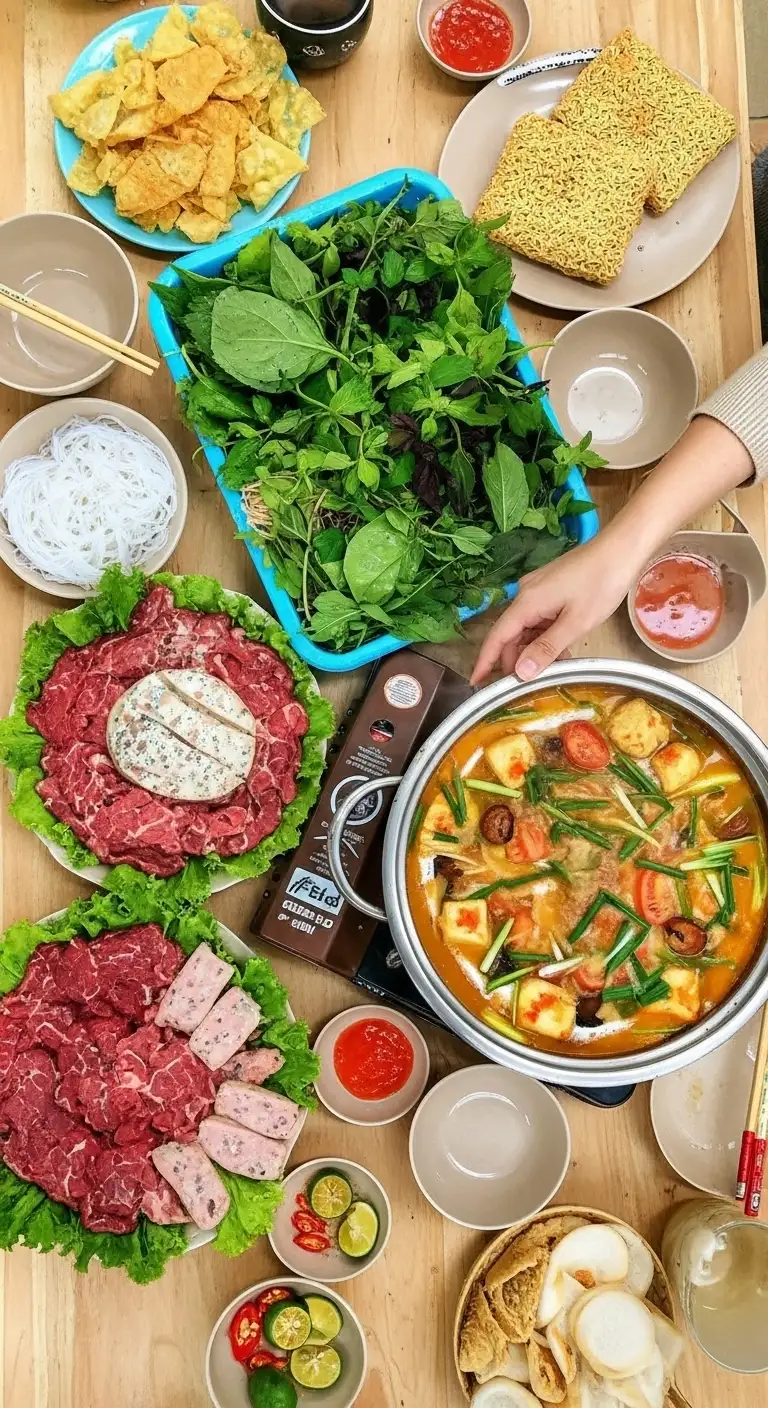Lẩu Riêu Cua (pronounced Low Ree-ew Koo-ah), or Field Crab Hot Pot, is a cherished Vietnamese dish, particularly popular in the Northern Delta region. Evolved from the classic Bún Riêu Cua (crab noodle soup), this hot pot is beloved for its light, tangy, and deeply savory broth, which highlights the natural richness of freshwater rice field crabs. It’s a rustic, soul-warming meal that embodies the spirit of Vietnamese countryside cooking.
Basic Information on Lẩu Riêu Cua
What is Lẩu Riêu Cua?
It is a hot pot centered around a unique, vibrant broth. The key element, Riêu Cua (crab paste/pulp), is created by meticulously pounding or grinding small freshwater crabs, straining the liquid, and cooking it until the crab proteins coagulate into a fluffy, savory raft (or “cake”) that floats on the surface.
The Broth (Nước Lẩu):
The broth is characterized by a harmonious balance of savory, sour, and mildly sweet flavors. The savory depth comes from the field crab stock, while the tartness is achieved using tamarind paste and sometimes fermented rice vinegar (dấm bỗng). The broth’s distinct, appetizing red-orange color comes from sautéed tomatoes and crab roe.
Key Components:
Riêu Cua: The floating, savory crab “cake” and the fatty crab roe.
Protein: Thinly sliced beef (bắp bò), fried tofu puffs, and sometimes fish cakes.
Vegetables: A colorful array, notably water spinach (rau muống), banana blossom (hoa chuối), water morning glory, and taro stems (dọc mùng).

Varieties of Lẩu Riêu Cua
While the core crab broth remains the same, Lẩu Riêu Cua often incorporates secondary proteins or special ingredients for variation:
Lẩu Riêu Cua Bắp Bò (Field Crab Hot Pot with Beef Shank):
The most common and popular version. Thin slices of premium beef shank are served alongside the crab broth, ready to be quickly cooked (nhúng) in the simmering liquid. The beef adds a layer of richness and succulence to the meal.
Lẩu Riêu Cua Sườn Sụn (Field Crab Hot Pot with Cartilage Ribs):
This variation features small, tender pieces of pork rib cartilage. These pieces are often slow-cooked in the broth beforehand or added early in the meal, providing a pleasant crunch and savory pork flavor that complements the crab.
Lẩu Riêu Cua Ốc (Field Crab and Snail Hot Pot):
Inspired by the noodle soup version, this adds fresh snails to the communal cooking ingredients. The snails are usually pre-cleaned and served on a platter, cooked briefly in the broth to give a chewy texture and a distinct flavor.
How to Eat Lẩu Riêu Cua
Lẩu Riêu Cua is a highly interactive, shared dining experience.
Broth and Tofu First: The hot pot is brought to the table, already simmering with the crab raft, tomatoes, and fried tofu puffs soaking up the flavors. Diners may take a small bowl of the initial broth as an appetizer.
Cook the Proteins: Thinly sliced beef is added to the boiling broth in small batches. It should be swished briefly (about 15–30 seconds) until just cooked to maintain tenderness, then removed.
Dipping: The cooked beef and tofu are dipped into a custom sauce, most commonly a simple mix of fish sauce, sliced chili, and possibly some lime juice or vinegar to cut through the richness.
Add the Greens: As the proteins are finished, a generous amount of fresh vegetables and herbs (especially the crunchy taro stems) are added to the pot to wilt and absorb the flavorful liquid.
Enjoy with Noodles: The meal is traditionally finished by placing rice vermicelli noodles (bún) in a bowl and ladling the rich, crab-flavored broth, soft tomatoes, tofu, and remaining vegetables over them, eating it like a soup.

Regional Differences in Lẩu Riêu Cua
While originating in the North, Lẩu Riêu Cua has been adopted across Vietnam, with each region adapting it to its local culinary preferences.
| Region | Broth Characteristic & Flavor Note | Signature Ingredients/Style | Key Difference |
|---|---|---|---|
| North (Hanoi, Hải Phòng) | Authentic and Balanced. The original style focuses on a delicate, savory, and clean tartness. | Lẩu Riêu Cua Dấm Bỗng: Traditionally uses dấm bỗng (fermented rice vinegar) for a sophisticated sour note and emphasizes the fresh Riêu Cua. | The flavor profile is less sweet and less oily, relying on the natural umami of the crab and the lightness of the broth. |
| Central (Huế, Đà Nẵng) | Spicier and More Aromatic. Incorporates more chili, lemongrass, and strong fermented pastes. | Often borrows from the Central region's love of bold spice. The accompanying vegetables may include more local bitter herbs. | The sourness and savory depth are often more intense, sometimes using stronger fermented shrimp paste (mắm ruốc) for a deeper umami profile. |
| South (Saigon, Mekong Delta) | Sweeter and Richer. Reflects the Southern preference for a generous sweetness and heartier flavors. | Lẩu Riêu Cua Thịt Bò: The broth is often noticeably sweeter (more sugar) and may be richer. More common to see a variety of meats and sometimes seafood added. | Vegetables tend to be more varied and abundant. The flavor is generally more accessible to a mass audience due to the pronounced sweetness. |




